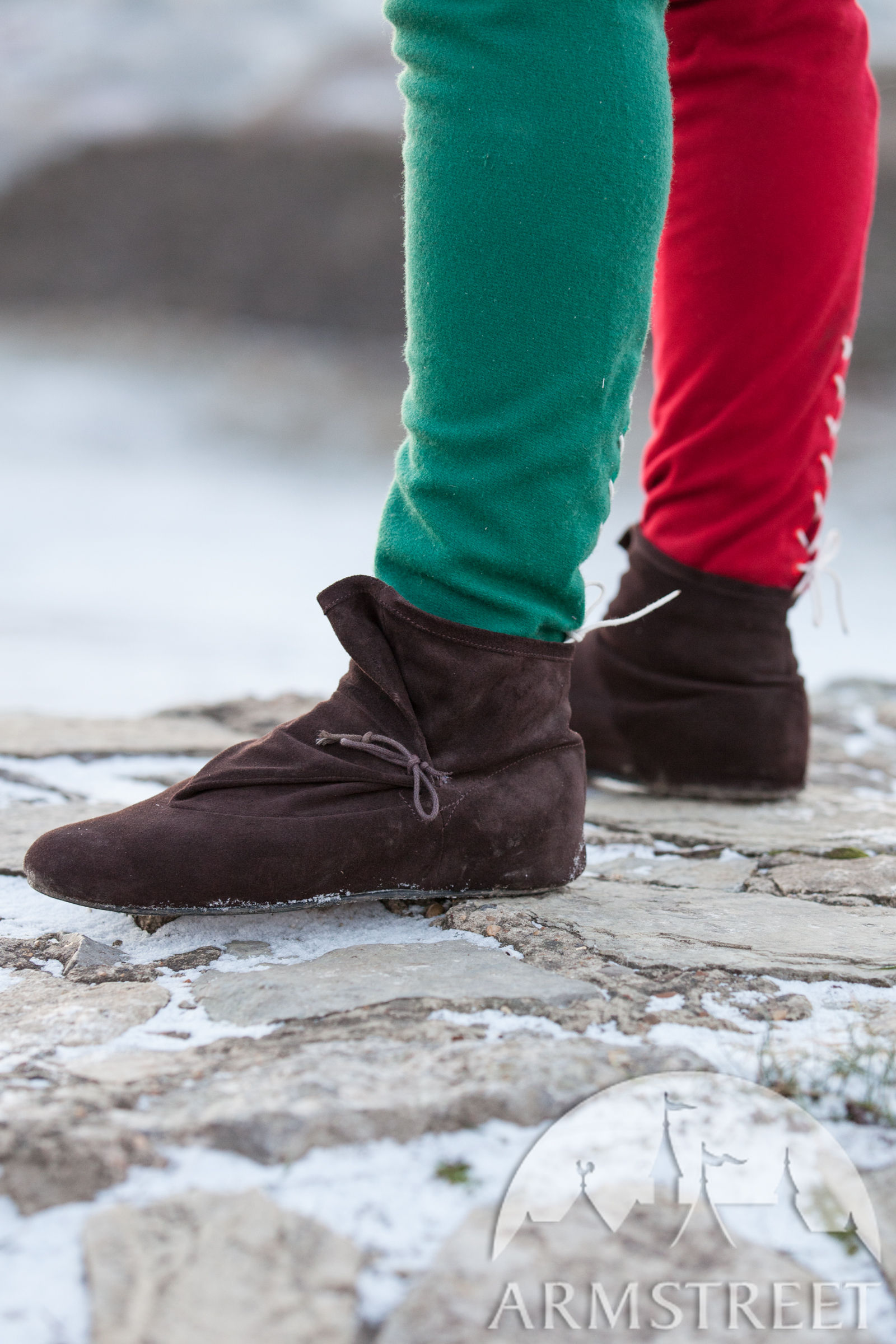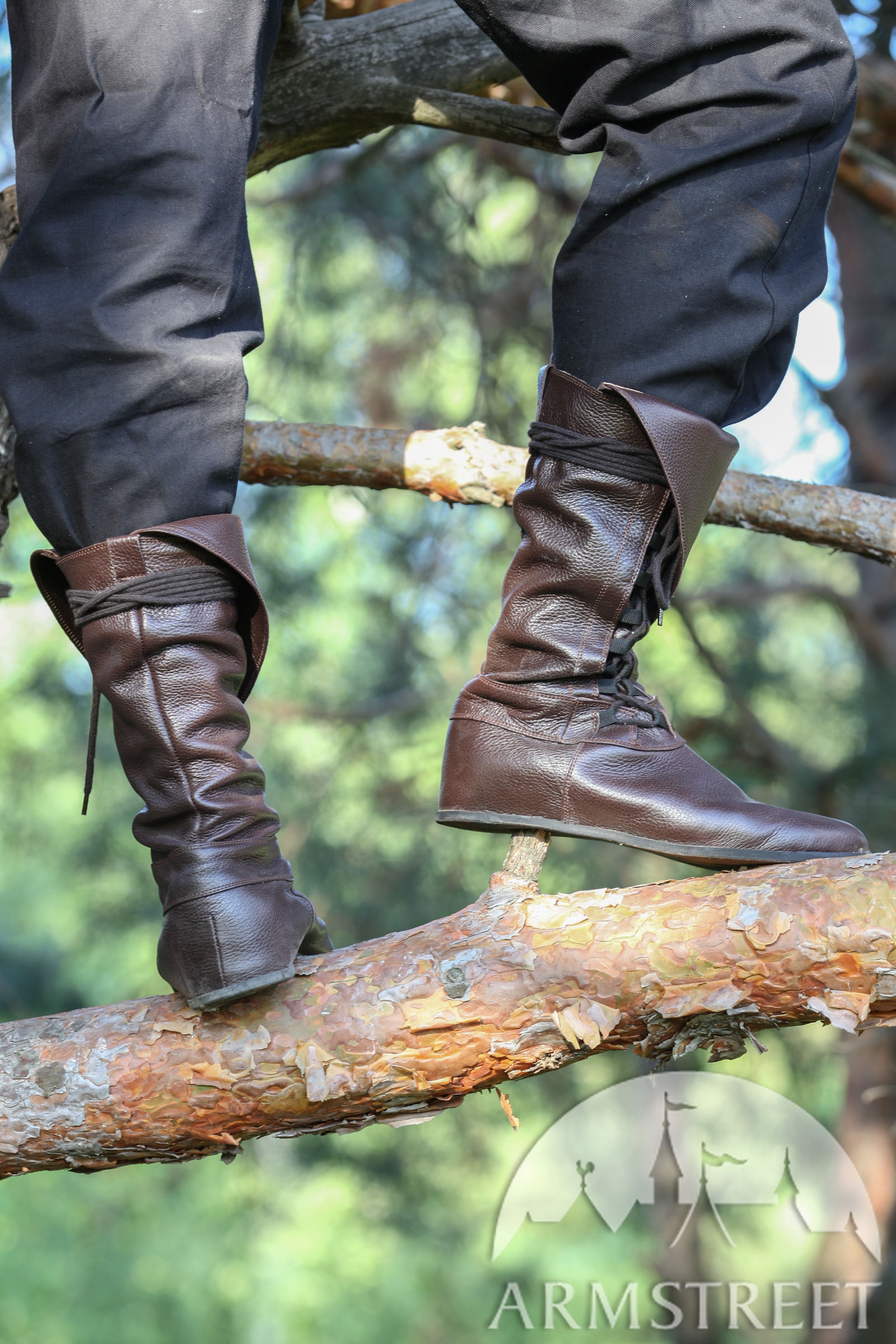
The pattern of wear on the boot could indicate a certain walking pattern in which the wearer transferred her weight to the heel and ball of the foot. Spots around the ball and heel of the boot were tattered and there were repair attempts on each boot, indicating the owner had used the shoes heavily before discarding them. There are areas of substantial wear and tear along the soles and attempts to repair the damage. The boots had an upper made from a single piece of leather and flaps that were stitched to the side. Determining the type of leather used is difficult but goat, sheep, and calfskin were the most common leather used for the production of boots by shoemakers at the time. Measuring 219mm high, 235mm long, and 90mm wide, these boots were worn by someone with a small foot, likely a woman. These mid thirteenth-century brown leather boots displayed at the Museum of London were excavated from a rubbish pit at the St Mary Spital hospital. Masculine style shoes worn by women contrasted sharply with other symbols of feminity and were considered quite provocative.Figure 1: Pair of leather boots displayed at the Museum of London from the 13th century found in a rubbish pit at the St Mary Spital Hospital. By the 1990s, however, it had become part of popular fashion. The shoe was initially designed as an orthopedic shoe in the 1940s. Martens boot, an orthopedic boot of the 1940s, became a style statement for the punk counterculture of the era. They all went well with the trendy miniskirt.īy the 1970s, styles converged, and men and women were rocking cowboy shoes, suede Chukka shoes, and high zip-up platform shoes. There were many popular styles, such as the flat-heeled, white kid leather André Courrèges shoes, Go-go ankle, knee or thigh boot that came with or without heels, and front lacing granny shoes which came later as a part of the hippie style. In the 1960s, women's fashion shoes became the rage. It featured high heels and a pointed toe and was usually paired with slim-fitting tapered trouser.

It was derived from the elastic side shoes of the nineteenth century. The Chelsea shoes, which later became known as "Beatle shoes," started to trend in the late 1950s. Inspired by movies like The Wild One and Rebel Without a Cause, the young rebels expressed their rebellion with the rugged Engineer or Bikers shoes. But the knee-high Russian shoes were still much in vogue with women.īoot witnessed a revival in the second half of the twentieth century with the emergence of the youthful counterculture of that period. They returned to more functional use, mostly military, sports, and safety applications. The barrette boot came later and was seen as a sort of shoe because the delicate straps were see-through.īoots began to gradually lose relevance in the fashion scene of the early twentieth century. By 1870, the side springs, high-buttons, and Balmoral shoes dominated fashion. However, it was replaced by front lace balmorals.īoot styles tended to accentuate the curves of the ankle and calf. The elastic side boot became the footwear of choice for women mid-century. The Hessian also continued to trend in the U.S in this period. The cowboy shoes are said to come from Kansas and incorporates design elements from both the Wellington and the Mexican vaqueros. Meanwhile, the Wellington survived in the U.S. The Balmoral or "bals," which was designed for Prince Charles, were the most popular. The two fashionable front lacing styled shoes were the Derby and the Balmoral. The two most popular styles in the midcentury were the elastic side of the Congress and the front lacing boot. This easy-to-wear slip-on style became popular with both men and women.

Sparkes Hall presented Queen Victoria with the first shoes to have elastic side gussets. Prominent among the women shoes for that period was the Adelaide, which featured side lacing and a flat heelless ankle boot.Īdvances in technology in the Victorian era peaked in the popularity of shoes. Most modern-day hiking shoes, high-top sneakers, and combat shoes were derived from the blucher.īy the 1790s, shoes for women started becoming markedly feminine with high-heels, tight lacing, and pointed toes.īoots for walking and daywear became popular encouraged by fashion periodicals, and by 1830, boots were a fashion staple. It later became casual sportswear and continued to be popular to this day, although slightly modified. The Blucher was another notable boot in the early nineteenth century and is named for a famous war hero.Īlso known as a "high-low," it was a utility, front-laced ankle boot used by laborers in the eighteenth century. The Wellington is essentially a Hessian that features a curved top cut straight across with a simple binding and was vastly popular for the first quarter of the nineteenth century.

It was said to have been developed by the Duke of Wellington in 1817.

The Wellington boot replaced the Hessian.


 0 kommentar(er)
0 kommentar(er)
